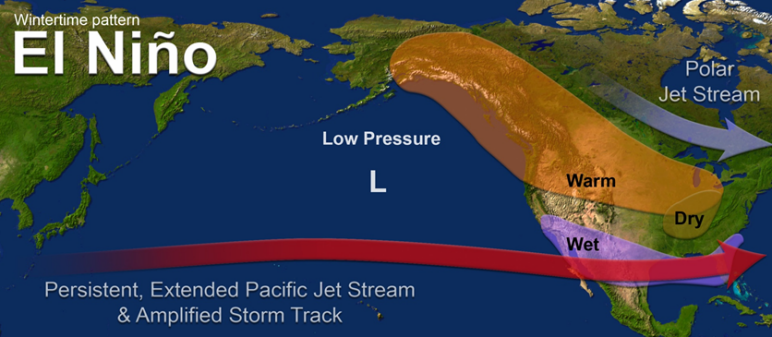The occasional development of surface waters of the ocean along the coastal regions is called as El Nino effect. This El Nino name was first given to the occasional development of warm water surface on the coastal surface of Peru and Ecuador.
El Nino effects reduce nutrient-rich deep ocean water and the usual decrease of upwelling of cold water is noted. These effects normally observed around December and may last up to a few weeks to months. In extreme cases, El Nino effects have lasted for years. El Nino effects which were developed in 1991 stayed till 1995.
Normal Weather Conditions (without El-Nino effect)
Normally, low surface pressure is developed in the coastal region of Indonesia and waters near Australia, and high pressure over the coastal region of Peru. This results in the movement of trade winds over the Pacific Ocean (Direction: East to West).
These easterly trade winds used to carry warm water of surface to the west direction which results in thunderstorms in Indonesia and Coastal region near to Australia, and New Zealand. In the coastal region of Peru, cold water is being replaced by warm water which is further pulled to the west.

When El Nino Effects occurs
El Nino affects changes in the course of normal weather patterns. Air pressure drops over the central pacific drops and along the coastal region of South America. The normal low-pressure system in Western Pacific is being replaced weak high system. This results in a change of pattern trade winds to be reduced.
This resulted in a reduction in trade winds allows the current along doldrums to accumulate warm water of ocean along the coastal lines of Ecuador and Peru. Accumulation of warm water results in thermocline to decrease in the eastern region of the Pacific Ocean. The thermocline is a temperature gradient in the water body (lake, ocean, river, etc.) in which the layer is separated at different temperatures. This stops the upwelling of cold water of the Deep Ocean in the coastal region of Peru.

This development leads to drought in western Pacific regions and precipitation in the Equatorial coast of South America. Also, storms and hurricanes developed in the Central Pacific region. This pattern of atmospheric circulation causes the formation of the El Nino effect.
Effects of El Nino effect
- Heavy precipitation in the North American regions like California, Ecuador, Mexico’s Gulf.
- Reduction in fishing along the coastal region of South America because of no upwelling of water.
- The devastating effect on marine life due to the warmer water of the Ocean.
- Lesser precipitation in the Indian subcontinent, Southern Africa, Indonesia, and Australia.
Impact of El Nino on Monsoon rainfall of India
Indian Monsoon rainfall and El Nino are inversely related to each other. That means, if one gets stronger, then others will be weaker. El Nino effects have brought the most prominent droughts in India. Since 1871, six such droughts were affected the Indian subcontinent badly. The latest Drought due to El-Nino was from 2002 to 2009.
It was not always that this effect brings drought in India. One of the strongest El-Nino years was 1997 but it doesn’t affect the Indian subcontinent but a moderate el-Niño effect affected India very badly in 2002. The agriculture system of India used to face the worst impact of the El-Nino effect as lesser precipitation results in lower production of summer crops like sugarcane, cotton, oilseeds, rice, etc.

